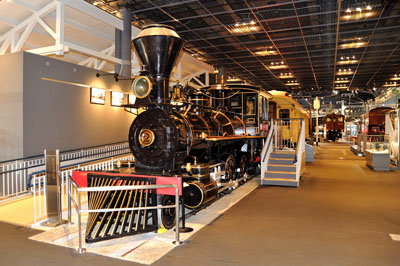
Steam Locomotive
Class 7100 |
The Benkei steam locomotive was the first used on Hokkaido's railroad system. |

|
|
Hokkaido is the northernmost island in Japan.
It had a different culture compared to the mainland until the 19th century. Japanese national seclusion ended and a new government style was established. Hokkaido also began a new reclamation. The mainland's new technologies were from the UK, but Hokkaido's new technologies were from the US.
Hokkaido's first railroad was planned for the purpose of transporting coal to the mainland via the Tsugaru strait. Therefore construction began under the mentorship of American supervision. The railroad was constructed from the embarkation port city of Otaru to the coal mine town of Horonai. The railroad was named the Government Horonai Railway. And then, it was partly opened between Otaru and Sapporo during January 1880. At the opening time, two 2-6-0 Tender steam locomotives were imported from the American builder H.K. Porter Inc (manufacturing serial numbers 368 and 369). These two engines received nicknames, which followed the American locomotive tradition. No.1 was "Yoshitsune" and No.2 was "Benkei". These names were from twelfth century popular historical characters. A total of eight engines were imported until 1889, and their manufactured numbers were 487, 488, 643, 672, 1009 and 1010. During 1889, Horonai Railway was transferred to the private railway company "Hokkaido Tanko Tetsudo Company" with locomotives and cars. Hokkaido Tetsudo renamed the above engines to Class A No.1-6 and 9-10 (later No.9 to No.8, No.10 to No.7), and later to Class "I" ("I" is actually pronounced "E" in Japanese.) But at this time, new numbers were assigned irrespective of original numbers. This has bewildered many railroad historians. Also many numbering mistakes were made when later preserved at museums. Hokkaido Tanko Tetsudo was nationalized in October 1906. Nationalized No.1-8 were renamed to Class 7100, No.7100-7107, when class names were revised during 1906. Around this time, 7100 retired to private life and rented to building office etc ..... For more details please consult the following biographic data chart. |
|
Class 7100 Comparative Chart
| |||||||||||||||||||||||||||||||||||||||||||||||||||||||||||||||||||||||||||||||
|
|
No.2 Benkei Biographic Data Chart
| ||||||||||||||||||||||||||||||||||||||||||||||||||||||||||||
|
Porter's Yoshitsune & Benkei manufacturing note. (1880) 
|
The Kaitakushi passenger car (1880 - 1923)
Hooked to the rear with Benkei No.2 in the museum, this passenger car is the "Kaitakushi". This car was one of the eight imported passenger cars in Hokkaido. It was imported together with the Benkei and Yoshitsune steam locomotives during 1880. This car was manufactured from Harlan and Hollingsworth Co. in the US. The imported eight passenger cars were ; Special class - 1 car, 1st class - 2 cars, 1st class with luggage room - 2 cars and 2nd class - 3 cars. Of these cars, Special class car No.1 earned the nickname of "Kaitakushi". The name "Kaitakushi" was Hokkaido's first governmental development agency.
After that, it was used for visitation purposes by government officials of the Hokkaido Development Agency etc. During 1889, the passenger cars were transferred to the Hokkaido Tanko Tetsudo Co with locomotives. But the situation was again reversed in 1906, so Kaitakushi was returned back to the Government Railway. No.1 was renamed to Class KoToKu-5010 during 1906. Afterwards, it was only used as a special vehicle. And KoToKu-5010 remained at Sapporo depot with almost no remodeling. During 1923, KoToKu-5010 was moved to Tokyo's Oi royal car shed for safekeeping. And later moved and exhibited at Manseibashi Transportation Museum during 1948. It was designated a Railway Monument during October 1961. During 1967 and 1989, it was reconstructed to it's original shape. And Kaitakushi was moved to Saitama's new Railway Museum with Benkei during October 2007. |
Introduction |
Go to Top |